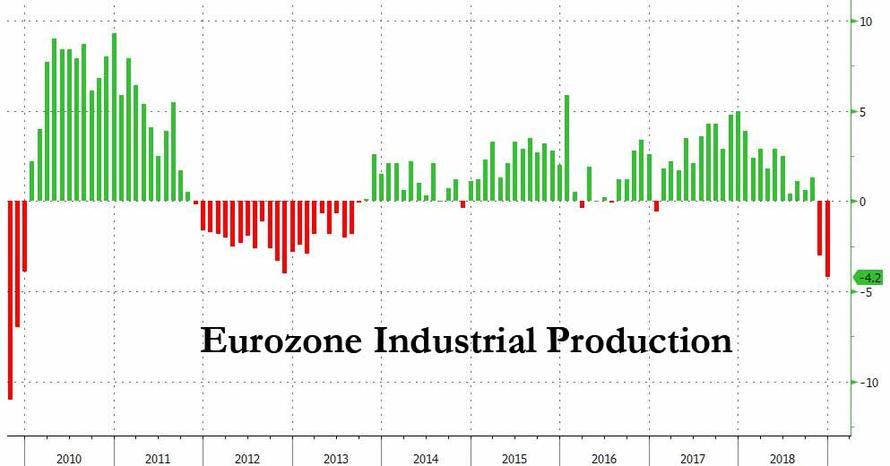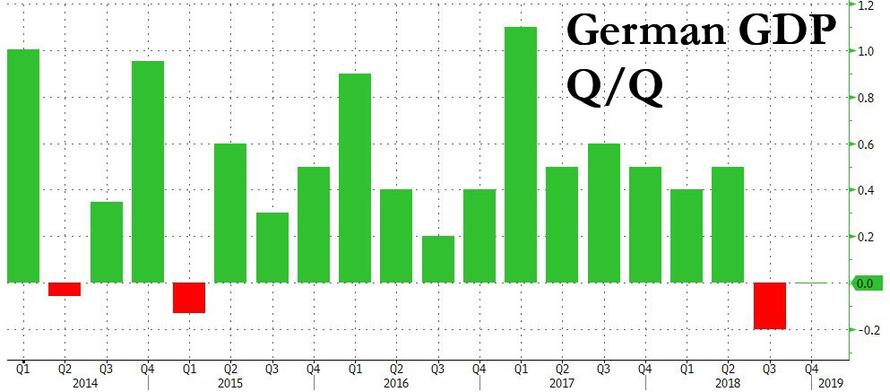Fra Zerohedge:
Confirming previous leaks that despite a sharp economic slowdown across most of Europe, which has emerged as the “weakest link” for the global economy…
… Europe’s manufacturing and exporting powerhouse, Germany, just barely avoiding a technical recession after its economy stagnated in the 4th quarter following a 0.2% Q/Q drop in Q3, although lack of a trade war resolution will likely mean that any pickup in Europe’s powerhouse economy could be muted.
After posting its worst GDP print in years, Germany’s economy was bolstered by domestic demand in the fourth quarter, as investment into buildings and equipment rose markedly. Also, in delight to fiscal doves everywhere, government spending increased significantly from the previous quarter, while private consumption was up fractionally. However, with exports and imports rising at roughly the same pace, there was no contribution from net trade, which is a problem for an economy that relies greatly on trade to grow its economy.
Despite the carefully seasonally adjusted Q4 GDP print, which strategically prevented “Germany Enters Recession” headlines on the front pages of tomorrow’s newspaper, Germany’s Q4 performance meant Europe’s biggest economy trailed most of its euro area peers, where average growth was 0.2 percent. 2019 hasn’t brought much relief so far: disappointing numbers keep rolling in and a slew of institutions have downgraded their outlooks.
Worse, as we noted yesterday, whereas the likes of Greece were at the root of past European sluggishness, this time Germany’s prospects are crumbling after a protracted slump in manufacturing and a big hit to German auto production.
That said, analysts are hopefully that the Q3 drop was the trough, and economists forecast growth of 0.4% in Q1 as rebounding car orders and rising water levels signal some one-off growth inhibitors are dissipating. Still, the full-year outlook depends on whether stabilizing trade and Chinese growth can revive industrial momentum.
Confirmation of Germany’s economic stagnation comes one week after the European Commission issued sweeping downward revisions for Germany and many of the euro area’s major economies, which as Bloomberg notes, “faces a daunting combination of weaker demand for its exports from China and the rest of the world, the prospect of a messy divorce with the U.K., and protracted impact from political unrest in Italy and France.”
Meanwhile, according to Bank of America economists, the current slowdown may prove temporary but relies “on accidents not happening.” U.S. threats to hike car import tariffs would need to dissipate, the U.K. would have to leave the European Union with a deal, and the Chinese economy would need to stabilize.
Yet business concerns this time are more entrenched than they were during the last growth scare, and that alone could weigh on investment. A gauge for manufacturing is signaling contraction, the Economy Ministry predicts the weak phase in industry to continue and Daimler AG is preparing a “comprehensive” cost-cutting program.
It wasn’t all doom and gloom, with some cheer coming from the Netherlands, which reported 0.5% growth in the fourth quarter, an acceleration from 0.1% in the previous three months.
So with Germany literally on the edge of recession, eyes turn to Mario Draghi, although any hopes of further easing by the central bank which recently ended its sovereign debt QE will likely be dashed for the foreseeable future as the ECB has signaled it won’t rush in with additional stimulus, and are waiting to see how to economy evolves before deciding to raise interest rates.
Which is why Germany’s Q1 GDP may be fateful: another unexpected contraction will likely force the central bank to jump back into the easing pool, although what more the central bank can do to stimulate the economy – considering its QE was still intact when Europe careened into a near recession – remains unknown.




